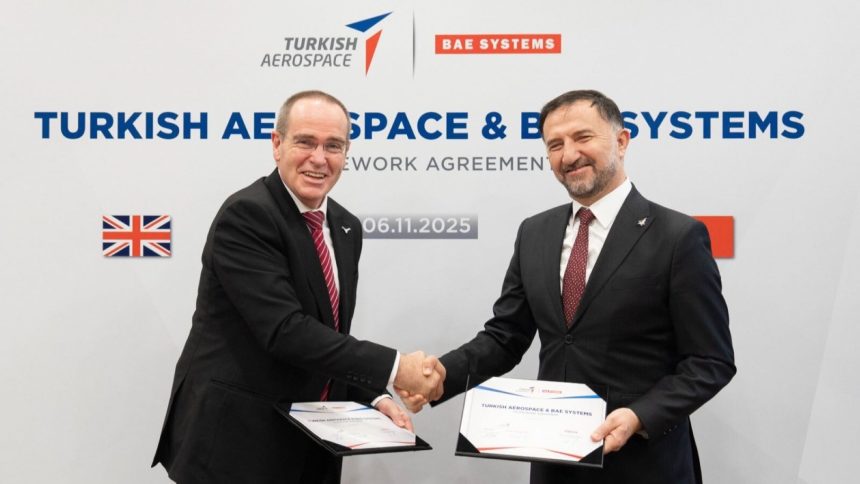The Memorandum of Understanding envisages both companies combining their complementary capabilities in development of unmanned systems and exploring new market opportunities.
Turkish Aerospace Industries (TAI or TUSAŞ – Türk Havacılık ve Uzay Sanayi A.Ş.) and U.K. arms major BAE Systems signed on Nov. 6, 2025 an MoU (Memorandum of Understanding) to jointly develop unmanned aerial systems.
Neither company has mentioned the specific role and class of unmanned systems to be developed, or if they have already identified an existing uncrewed platform from TAI’s existing product line for use within Turkey. The latter is likely, given that both companies have stressed on mating their respective strengths, with existing aircraft in the class and advanced mission systems for customization and marketing experience to secure sales.
We have signed a strategic Memorandum of Understanding with BAE Systems to collaborate on on the development of uncrewed air systems.
Under the signed Memorandum of Understanding, both parties will target joint opportunities in the field of future uncrewed air systems. pic.twitter.com/YhpytHFlE3
— Turkish Aerospace (@TUSAS_EN) November 6, 2025
Combining strengths to rapidly develop unmanned systems
TAI said on X: “Under the signed Memorandum of Understanding, both parties will target joint opportunities in the field of future uncrewed air systems.” BAE Systems’ X post said the agreement “combines their expertise in uncrewed air systems,” defining the MoU as “a powerful alliance combining our rich and extensive UAS skills and portfolios.”
BAE’s separate press release similarly called the MoU a “strategic alliance” meant to “explore opportunities to collaborate on the development of uncrewed air systems (UAS).” Additionally, the company said “the agreement will see experts from Turkish Aerospace […] work together with BAE Systems’ combat air experts, to explore common opportunities on uncrewed systems.”
The press release also quoted BAE Systems FalconWorks’ division managing director Dave Holmes, who said each company brings “complementary skills and capabilities […] and a strong portfolio of uncrewed assets which we can leverage […] to create a range of compelling and cost-effective solutions.”
We’re excited to have signed an agreement with Turkish Aerospace @TUSAS_EN to combine our expertise in uncrewed air systems.
A powerful alliance combining our rich and extensive UAS skills and portfolios. pic.twitter.com/J9wM0IhruB
— BAE Systems Air (@BAESystemsAir) November 6, 2025
TAI CEO Mehmet Demiroğlu said the agreement “will allow us to bring our already proven uncrewed systems capabilities to new heights.” He further added “We want to jointly explore how we can accelerate progress and new market opportunities in this field.”
What aircraft would they develop?
The only aircraft fitting the “existing” and “proven” unmanned systems category is the flying-wing Anka III, which has been tested with air-to-ground weapons. A twin-engined supersonic version is also planned for the future.
Other recent Turko-European defense partnerships follow the same industrial template. The Baykar-Leonardo 50:50 joint venture, called LBA Systems, has hinted towards Italy’s interest in the former’s Akinci and Kizilelma UCAVs. Both companies have stressed on combining their respective strengths in ready, extensively tested aircraft, and advanced mission systems, avionics and sensor fusion.
ANKA III pic.twitter.com/905l1lMEfI
— Cem Doğut (@DogutCem) October 5, 2025
TAI’s Anka III is also meant to fly alongside existing and future Turkish fighters like the KAAN. TAI possesses a large manufacturing capacity that can be localized elsewhere.
BAE Systems, meanwhile, leads in mission systems, networking, data linking and sensor fusion technologies.
The new aircraft could most likely be a heavily Europeanized version of the Anka III. Producing a clean-sheet design would take longer, and not meet many customers’ immediate CCA/UCAV fielding needs. The product would also most certainly be pitched internationally, beyond Europe.
Turkey-Britain defense ties
Further marking the emerging Turkey-British defense commercial ties is Ankara signing on for 20 Eurofighter Typhoons, with reviving British manufacturing and jobs being the bedrock of the deal, according to UK Prime Minister Keir Starmer.
Turkish ANKA III UCAV achieved a new milestone by successfully launching the Süper Şimşek from its wing station.
Süper Şimşek is a 700 km-range, 0.9 Mach air-launched system with a 35 kg warhead.
It serves as both a target drone and cruise missile, capable of EW, decoy,… pic.twitter.com/9d0Yo5relx
— Clash Report (@clashreport) April 8, 2025
Turkey would also acquire twelve of the RAF’s retired C-130J Hercules aircraft, following refurbishment by Marshall Aerospace. The TAI Hürjet has been pegged as a contender for the UK’s next jet trainer aircraft.
These are however general defense acquisition projects to meet immediate aircraft recapitalization needs. They are not in response to new warfare trends driven by rapidly accelerating technologies that would characterize future battlefields, requiring long term R&D and manufacturing capacity building.
European defense majors partnering outside the continent
In July, Airbus and U.S. company Kratos also partnered up for the latter’s XQ-58A Valkyrie, a “flight-proven UCCA (uncrewed collaborative combat aircraft).” The Valkyrie would be “equipped with an Airbus-made mission system and combat ready for the German Air Force by 2029,” and “accelerate Europe’s ability to defend itself while fostering NATO’s transatlantic ties.”
Türkiye Cumhuriyeti Cumhurbaşkanlığı Savunma Sanayii Başkanı Haluk Görgün ile İtalya Savunma Bakan Yardımcısı Matteo Perego di Cremnago, İtalya Hava Kuvvetleri Komutanı Korgeneral Antonio Conserva, İtalya Kara Kuvvetleri Komutanı Korgeneral Carmine Masiello, İtalya Deniz… pic.twitter.com/jbU9EgAUyH
— BAYKAR (@BaykarTech) October 6, 2025
Along with the sixth-generation Global Combat Air Program (GCAP) of the UK, Italy and Japan, the Airbus-Kratos effort shown as European arms makers are collaborating outside the continent, in Western and non-Western countries of the G7 grouping.
The manufacturing and R&D capacities of Western and Asian companies would be limited to meet the massive future market in Europe, North America, and Asia for a variety of UCAVs and next-generation air combat platforms – disruptive technologies that have exploded onto the scene. The Baykar-Leonardo, TAI-BAE and Kratos-Airbus partnerships are a result of this need to pool development and production resources.









